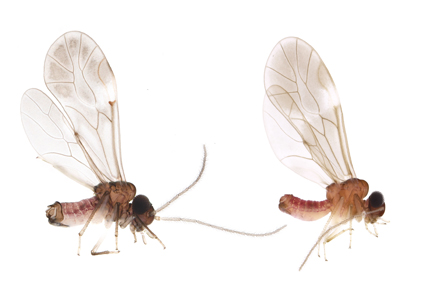Abstract
Bicuspidatus is a small genus of the family Peripsocidae, erected by Li (1993) with B. pulchipunctatus as the type species. Adults of this genus can be easily distinguished from other peripsocids by the phallosome with bicuspid apical process in males or by the subgenital plate with modestly elongated, distally bilobed posterior lobe in females. Bicuspidatus currently comprises three species: B. guangdongensis Li, 1993, B. pulchipunctatus Li, 1993 and B. sigillatus Li, 1993, all are known only from Guangdong Province, China. According to previous studies, these three species can be distinguished by the markings on the forewings and a few characteristics of phallosome (Li 1993, 2002). In this study, we present a taxonomic revision of Bicuspidatus based on examination of 40 specimens collected from various localities, including the type specimens of B. guangdongensis, B. pulchipunctatus and B. sigillatus. Furthermore, 12 of them were used for molecular analyses based on partial sequences of COI gene. As a result, B. guangdongensis and B. sigillatus are here considered as junior synonyms of B. pulchipunctatus. We redescribe B. pulchipunctatus and describe a new species from Xizang Autonomous Region, China. An updated distribution map and a revised key to the species of Bicuspidatus are also provided.
References
- Folmer, O., Black, M., Hoeh, W., Lutz, R. & Vrijenhoek, R. (1994) DNA primers for amplification of mitochondrial cytochrome c oxidase subunit I from diverse metazoan invertebrates. Molecular Marine Biology and Biotechnology, 3, 294–299.
- Kimura, M. (1980) A simple method for estimating evolutionary rates of base substitutions through comparative studies of nucleotide sequences. Journal of Molecular Evolution, 16 (2), 111–120. https://doi.org/10.1007/BF01731581
- Kumar, S., Stecher, G. & Tamura, K. (2016) MEGA7: molecular evolutionary genetics analysis version 7.0 for bigger datasets. Molecular Biology and Evolution, 33, 1870–1874. https://doi.org/10.1093/molbev/msw054
- Li, F.S. (1993) Psocoptera from National Chebaling Nature Reserve. In: Editor Committee of the Collected Papers for Investigation in National Chebaling Nature Reserve. (Ed.), Collected papers for investigation in National Chebaling Nature Reserve. Guangdong Science & Technology Press, Guangzhou, pp. 365–382.
- Li, F.S. (2002) Psocoptera of China. Science Press, Beijing, 1976 pp.
- Nylander, J.A.A. (2004) MrModeltest. Vol. 2. Program Distributed by the Author, Evolutionary Biology Centre, Uppsala University, Uppsala. [program]
- Ronquist, F. & Huelsenbeck, J.P. (2003) MrBayes 3: Bayesian phylogenetic inference under mixed models. Bioinformatics, 19, 1572–1574. https://doi.org/10.1093/bioinformatics/btg180
- Trifinopoulos, J., Nguyen, L.T., von Haeseler, A. & Minh, B.Q. (2016) W-IQ-TREE: a fast online phylogenetic tool for maximum likelihood analysis. Nucleic Acids Research, 44, W232–W235. https://doi.org/10.1093/nar/gkw256
- Yoshizawa, K. (2005) Morphology of Psocomorpha (Psocodea: ‘Psocoptera’). Insecta Matsumurana, 62, 1–44.


